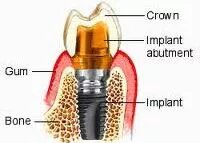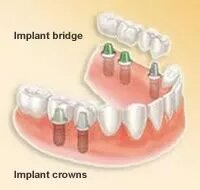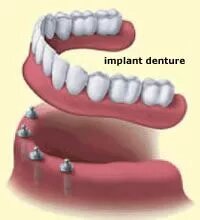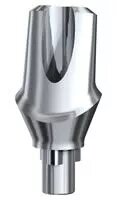Dental Implants
Has anyone ever suggested that you get a dental implant?

Have you wondered what a dental implant is?
There are several different types of dental implants. The most popular and frequently used is the root form implant (endosseous.) A root form dental implant is a small, medical grade titanium device which resembles a screw. They are placed inside the jawbone and contain connections that will support a crown, a group of crowns (bridge) or a full or partial denture once the implant has integrated (fused) with the bone.
Why a dental implant instead of a bridge, partial or denture?
Dental implants can solve problems that dentistry previously had no solutions for. For example, dental implants can:
- Replace lost teeth without requiring you to wear an appliance you will have to take in and out like a denture or a partial.
- Replace missing teeth without having to place crowns on either side of the empty space as required for a bridge.
- Prevent loss of jawbone in the areas where teeth are lost

When used instead of implants to replace missing teeth, removable dental appliances such as partial and full dentures can have the psychological disadvantage of making people feel older than they otherwise feel. Chewing ability with the tissue supported partial and full dentures is also decreased.
Implant supported crowns have a longer average expected life and are generally easier to clean and maintain than dental bridges.
Will dental implants work for you?
Dental implants are most predictable and successful in patients with sufficient, strong bone in which to place them. Determining whether you have enough strong bone is a job for your dentist, periodontist or oral surgeon. Although success rates vary according to patient and the location of the implant site, the overall success rate is approximately 95%.

If you have uncontrolled diabetes delayed healing due to poor peripheral blood circulations may cause implant failure. Patients on I.V. (e.g., Aredia, Zometa) or oral bisphosphonate medication (e.g., Fosamax, Boniva, Actonel, Aclasta) to fight cancer or prevent / treat osteoporosis may not be good candidates because of the risk of developing ONJ, osteonecrosis of the jaw – a melting or resorption of bone. Additionally, if you are a smoker, grind your teeth, have certain types of heart disease or have undergone radiation therapy to the head and/or neck or are immunosuppressed the probability of your implant success may dramatically decrease so you will need to be carefully evaluated individually.
How are dental implants placed?
Before implant placement occurs careful patient evaluation and surgical planning must take place. Clinical examination, x-rays and often C-T scans are used to plan placement of the implants and fabricate a surgical guide to avoid vital structures and help insure implant success. Bone grafting (augmentation) and/or other preparatory procedures may be necessary where there is inadequate depth or width of bone to support the implant.

Once the site(s) have been identified the implant is surgically placed inside the jawbone then either (1) sealed with a cover screw beneath gum tissue sutured over it (2) sealed with a healing collar with gum tissue sutured around it or (3) sealed with an abutment, then covered with a cap with tissue sutured around it until it is time to attach a crown, bridge or denture to the implant(s).

How is the crown, bridge or denture attached to the implant?
Dental implants are generally given 3-4 months to integrate (fuse) to the jawbone before anything is attached to them. However, in some cases, early loading (attachment) at 1-11 weeks or immediate loading (at the time of implant placement) is possible, especially directly after tooth extraction.
In order to connect the implant with a restoration (crown, bridge, partial or denture) an abutment, (coupler) is secured inside the implant and the restoration is secured over the abutment(s).

How much do dental implants cost and does insurance cover them?
The cost of replacing a single tooth with a 3 unit bridge is approximately the same as single tooth root form (endosseous) implant to replace the tooth. This does not include any procedures needed in order to prepare the bone for implant placement. The exact dollar amount will vary depending upon whether your dental and/or medical insurance covers the dental implant procedures and to what extent. Most dental insurance policies do not cover implants however some do and some medical insurance covers placement of implants. The best way to get an idea of the cost for you is to contact your dental office.
Few dental insurance plans cover dental implants. The degree to which the cost is covered varies according to the plan purchased by the employer (or the patient if it is an individual plan). Even though dental implants may not be a covered benefit, dental financing can make implants affordable.
Would you like to see if dental implants are right for you? Contact us to make an appointment.
